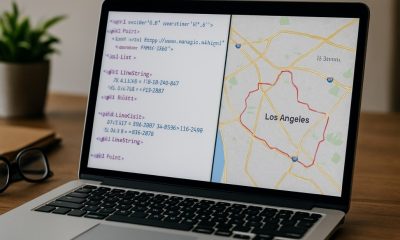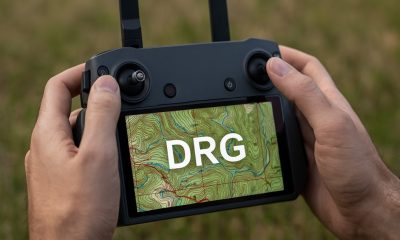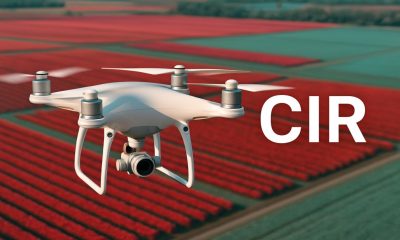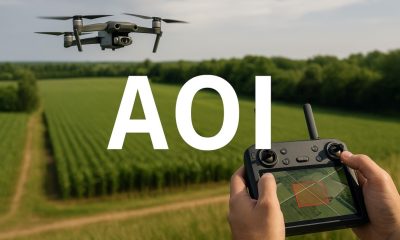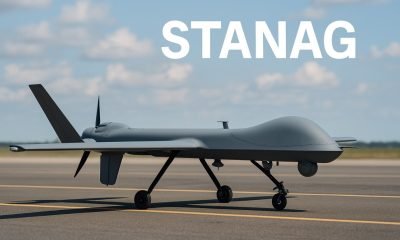- Acronym Guide
- AAM
- ABS
- AC
- ACAS
- ADS-B
- AFAC
- AGL
- AI
- AIM
- ALS
- AM
- AMA
- ANSP
- AOI
- APPI
- AUV
- AUVSI
- ARPAS-UK
- ASTM
- ATC
- BVLOS
- CAA
- CAAC
- CAB
- CASA
- CATT
- CBO
- CBR
- CBRN
- CDMA
- CDR
- CFR
- CIR
- COA
- COMINT
- CORS
- COTP
- COTR
- CPTED
- CV
- C2
- DAA
- DEM
- DFI
- DFS
- DGCA
- DHS
- DOD
- DPA
- DPEs
- DRG
- DRO
- DSM
- DSMX
- DSP
- DSSS
- DTM
- EASA
- EFT
- EO
- EOD
- EO/IR
- ELINT
- EMI
- ESC
- EVLOS
- eVTOLs
- FAA
- FCC
- FCS
- FHSS
- FICCI
- FLIR
- FOB
- FOV
- FPS
- FPV
- GBDAA
- GCP
- GCS
- GDPR
- GML
- GNSS
- GPS
- GSD
- GVC
- HDR
- HOGE
- IACRA
- ICAO
- ICS
- IMU
- INS
- IR
- ISA
- ISR
- ITU
- JARUS
- LAAMS
- LAANC
- LAATM
- LAI
- LBA
- LIDAR
- LOS
- LSALT
- MAC
- MAVLink
- MLIT
- MMS
- MSL
- MTOM
- NDAA
- NCSL
- NFZ
- NIST
- NMEA
- NOTAM
- NPA
- NPRM
- NTIA
- OBIA
- OEM
- OFDM
- OOP
- PASM
- PAV
- PCV
- PdM
- PEC
- PIC
- PID
- PIPL
- PLD
- PM
- PN
- PPK
- PPS
- PSM
- PWM
- UAM
- UAOP
- UAS
- UASTM
- UAV
- UCAVs
- UHD
- UHF
- USV
- UTM
- RAIM
- RCC
- RCS
- RFI
- ReOC
- RePL
- RMS
- ROI
- RPAS
- RPC
- RTH
- RTK
- SaR
- SAR
- SARP
- SBAS
- S.Bus
- SBIR
- SEDENA
- SfM
- SFOC
- SIGINT
- SLAM
- SMS
- SORA
- STANAG
- STTR
- sUAS
- TCAS
- TCCA
- TFR
- TIN
- TOF
- TP
- TPS
- TSA
- VHF
- VLOS
- VTOL
Drone Acronyms
What is CAA (Civil Aviation Authority) & How Does it Work?
By
Jacob StonerTable Of Contents

Definition
CAA stands for Civil Aviation Authority. It is a government or independent regulatory body responsible for overseeing and regulating all aspects of civil aviation within a particular country or region. The CAA’s responsibilities typically include ensuring the safety, security, and efficiency of air transport, certifying aircraft and pilots, regulating air traffic, and enforcing aviation laws and regulations.
Usage
The CAA is the primary authority that sets and enforces regulations for the operation of aircraft, including drones, within its jurisdiction. It ensures that all aviation activities, from commercial airlines to drone operations, comply with established safety standards. The CAA also manages the certification process for pilots, air traffic controllers, and other aviation professionals.
Relevance to the Industry
The CAA is crucial for the regulation and growth of the aviation industry, including the rapidly expanding drone sector. By providing a structured regulatory framework, the CAA ensures that drone operations are conducted safely and legally. Compliance with CAA regulations is mandatory for all drone operators, whether for commercial or recreational purposes.
How Does the Civil Aviation Authority (CAA) Work?
Organizational Structure:
- National Jurisdiction:
- Independent or Governmental Body: The CAA operates either as an independent regulatory agency or as a governmental department, depending on the country. It is responsible for overseeing all civil aviation activities within its jurisdiction, including the management of airspace and the regulation of all types of aircraft, including drones.
- Divisions and Departments: The CAA typically comprises various divisions, each focusing on specific aspects of aviation, such as safety oversight, air traffic management, pilot and aircraft certification, and regulatory compliance.
- Regulation Development:
- Policy Formulation: The CAA develops and implements aviation regulations and policies to ensure safety, security, and efficiency in the national airspace. These policies are often aligned with international standards set by bodies such as the International Civil Aviation Organization (ICAO).
- Stakeholder Consultation: Before finalizing regulations, the CAA consults with various stakeholders, including airlines, drone operators, manufacturers, industry experts, and the public, to gather input and ensure that the regulations are practical and effective.
Certification and Licensing:
- Pilot and Operator Certification:
- Training and Examination: The CAA certifies pilots and drone operators by ensuring they meet the required training and competency standards. This includes conducting written exams, practical tests, and background checks.
- Issuance of Licenses: Upon successful completion of the required training and assessments, the CAA issues licenses or certificates that authorize individuals to operate aircraft or drones within the national airspace.
- Aircraft and Drone Certification:
- Airworthiness Standards: The CAA certifies aircraft, including drones, by conducting rigorous inspections and tests to ensure they meet airworthiness standards. This process involves evaluating the design, manufacturing, maintenance, and operational capabilities of the aircraft.
- Operational Approvals: For certain types of drone operations, such as those involving beyond visual line of sight (BVLOS) or operations in controlled airspace, the CAA may require additional approvals or permits.
Safety Oversight and Enforcement:
- Safety Audits and Inspections:
- Regular Audits: The CAA conducts regular safety audits and inspections of airlines, drone operators, airports, and air traffic control facilities to ensure compliance with safety regulations. These audits assess the implementation of safety management systems, operational procedures, and maintenance practices.
- Incident Investigation: In the event of an aviation incident or accident, the CAA conducts a thorough investigation to determine the cause and recommend corrective actions. The findings from these investigations are used to improve safety standards and prevent future occurrences.
- Enforcement of Regulations:
- Compliance Monitoring: The CAA monitors compliance with aviation regulations through surveillance, reporting systems, and on-site inspections. It ensures that all operators adhere to the established rules and guidelines.
- Penalties and Legal Action: In cases of non-compliance, the CAA has the authority to impose penalties, such as fines, suspension or revocation of licenses, and grounding of aircraft. In severe cases, the CAA may take legal action against violators.
Air Traffic Management:
- Airspace Management:
- Air Traffic Control (ATC): The CAA oversees air traffic control operations to ensure the safe and efficient movement of aircraft within the national airspace. This includes managing flight routes, coordinating takeoffs and landings, and preventing collisions.
- Integration of Drones: The CAA works on integrating drones into the airspace by developing UAS Traffic Management (UTM) systems, which coordinate drone operations with manned aircraft to avoid conflicts and ensure safety.
- International Collaboration:
- Global Standards Alignment: The CAA collaborates with international aviation organizations, such as ICAO, to harmonize regulations and standards across countries. This collaboration ensures that the national aviation regulations are consistent with global best practices.
- Cross-Border Operations: The CAA manages the oversight of foreign aircraft and drones operating within its airspace, ensuring they comply with both domestic and international regulations.
By executing these functions, the Civil Aviation Authority (CAA) plays a crucial role in maintaining the safety, security, and efficiency of the aviation industry, including the growing drone sector. Its comprehensive oversight ensures that all aviation activities are conducted within a regulated framework, protecting both the public and the integrity of national airspace.
Example in Use
“The drone operator applied for a permit from the Civil Aviation Authority to conduct aerial surveys, ensuring compliance with national aviation regulations.”
Frequently Asked Questions about CAA (Civil Aviation Authority)
1. What are the primary functions of the CAA?
Answer: The primary functions of the CAA include:
- Regulation and Oversight: Developing and enforcing regulations for the safe operation of all aircraft, including drones.
- Certification: Certifying pilots, aircraft, and air traffic controllers to ensure they meet safety standards.
- Air Traffic Management: Managing air traffic control systems to ensure the safe and efficient movement of aircraft within national airspace.
- Safety Audits: Conducting regular safety audits and inspections to ensure compliance with aviation laws and standards.
- Incident Investigation: Investigating aviation incidents and accidents to improve safety and prevent future occurrences.
2. How does the CAA regulate drone operations?
Answer: The CAA regulates drone operations by:
- Issuing Permits and Licenses: Requiring drone operators to obtain permits or licenses for certain types of operations, particularly those involving commercial activities or operations in controlled airspace.
- Establishing Safety Guidelines: Setting guidelines for safe drone operation, including altitude limits, no-fly zones, and requirements for maintaining visual line of sight.
- Enforcing Compliance: Monitoring and enforcing compliance with drone regulations through penalties, fines, and other legal actions against violators.
- Promoting Education: Providing educational resources and training programs to ensure that drone operators understand and adhere to safety regulations.
3. What is the role of the CAA in international aviation?
Answer: The role of the CAA in international aviation includes:
- Collaboration: Working with international aviation bodies such as the International Civil Aviation Organization (ICAO) to harmonize aviation standards and practices across countries.
- International Agreements: Participating in and enforcing international agreements and treaties related to aviation safety, security, and environmental protection.
- Oversight of Foreign Operations: Regulating and overseeing the operations of foreign aircraft and operators within the national airspace, ensuring they comply with domestic and international regulations.
For examples of these acronyms visit our Industries page.
As the CEO of Flyeye.io, Jacob Stoner spearheads the company's operations with his extensive expertise in the drone industry. He is a licensed commercial drone operator in Canada, where he frequently conducts drone inspections. Jacob is a highly respected figure within his local drone community, where he indulges his passion for videography during his leisure time. Above all, Jacob's keen interest lies in the potential societal impact of drone technology advancements.


